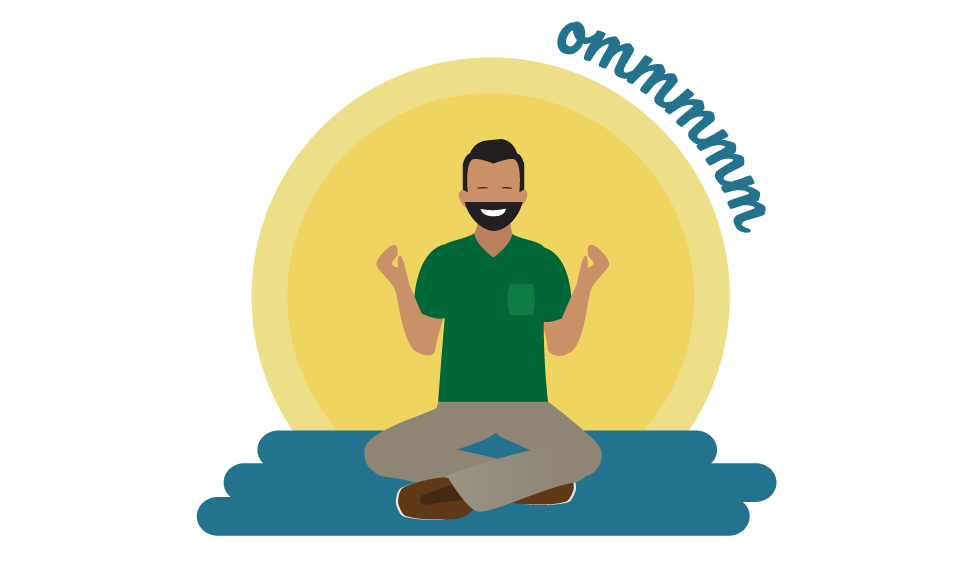Build a Foundation of Mindfulness
Learning Objectives
After completing this unit, you’ll be able to:
- Articulate why mindfulness is important, including how it can benefit your team.
- Describe the difference between mindfulness and meditation.
- Explain the importance of breath and the mind-body connection.
How Mindfulness Transforms the Way We Live and Work
With 30% of workers reporting severe stress, anxiety, or depression within the last 2 years (as we learned in the Wellbeing at Work module), it’s more important than ever for each of us to have the insights and resources we need to go from surviving to thriving. Less stressed employees are healthier, happier, more innovative, and more engaged. And that means lower healthcare costs, increased productivity, and a sharper workforce for your business.
There’s more. According to the American Psychological Association, practicing mindfulness has both group and individual benefits, including:
- Reduced stress
- Better sleep
- Increased focus and memory
- Less emotional reactivity
- Greater self-observation
When you and your team prioritize mindfulness, you also build resiliency. As a result, you’re able to deal more effectively with day-to-day stresses at home and in the office.

So, What Is Mindfulness?

“Mindfulness is a kind of energy that helps us be fully present in the here and the now, aware of what is going on in our body, in our feelings, in our mind and the world, so that we can get in touch with the wonders of life that can nourish and heal us.” —Zen Master Thich Nhat Hanh
Acclaimed global spiritual leader, poet, and peace activist Thich Nhat Hanh is the founder of Plum Village in southwest France, Europe’s largest Buddhist monastery and the world’s largest mindfulness practice center. He knows a thing or two about creating a mindful environment.
According to Plum Village, “Mindfulness is the energy of being aware and awake to the present moment. [...] We bring our body and mind into harmony while we wash the dishes, drive the car, or take our morning shower.” At Plum Village, even common daily activities such as walking, eating, and working are practiced in a way that is intentional and mindful.
But mindfulness isn’t just for monks! Consider incorporating it into the essential activities of your daily routine—such as when you’re eating, listening, or walking. Mindfulness of our body, in particular breathing, is the foundation that we can build upon to become more aware of what is going on inside and outside of ourselves no matter where you are or what you’re doing. In the end, mindfulness is a journey that opens up remarkable new perspectives and possibilities in our life, work, and relationships.
How Is Mindfulness Different from Meditation?
You may have heard the two terms used interchangeably, but there is an important difference between mindfulness and meditation.
- Mindfulness is about bringing our attention to the here and now in order to be fully present and aware in the moment.
- Meditation comes from a Sanskrit term bhavana meaning “cultivation” or “development.” It refers to the practice of cultivating positive habits like mindfulness, compassion, and understanding.
The two practices work together harmoniously. For example, you can use mindfulness to become more aware in your meditation practice—like being mindful of how many times your thoughts drift to your to-do list during meditation. Likewise, practicing meditation can be a great way to build your capacity to be mindful.
Focusing on Your Breath

“In our daily life very often our body is there, but our mind is elsewhere. Our mind is in the future, in our projects, in the past, caught in anger, fear, anxiety, and very seldom our mind is with our body. That is why, when you bring attention to your in-breath, and breathe in, you bring your mind home to your body.” —Zen Master Thich Nhat Hanh
Breath is a basic yet powerful tool—regardless of where you are or how you’re feeling, your breath is always with you. That makes it an ideal anchor for your mind whenever you feel carried away, lost in deep emotion, or scattered with worry. You can always restore your calm by returning to your breath.
You can do it quickly and easily at any time of day to help reduce stress. It takes just a minute or two to recenter yourself during your daily activities (think: your commute to work, waiting in line, or riding the elevator).
Before we show you how, watch this short video clip about the importance of breath from Thich Nhat Hanh’s dharma talk, Breathe as a Free Person, Walk as a Free Person .
Resources
- American Psychological Association: What are the benefits of mindfulness?
- Plum Village: Mindfulness Practice
- Learn more about spiritual leader Thich Nhat Hanh